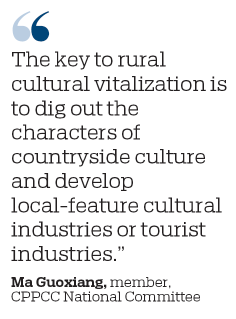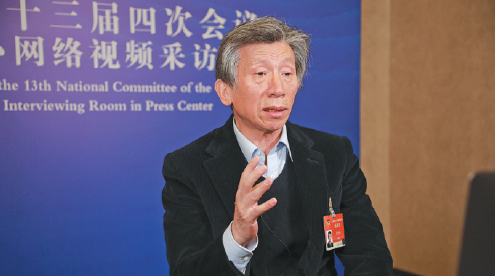Cherishing our rural heritage

Revitalizing villages will help breathe new life into isolated communities and inspire cultural activities and appreciation, says CPPCC member, Li Yingxue reports.
The outline of the 14th Five-Year Plan (2021-25) for national economic and social development was ratified during the annual two sessions, mapping out a blueprint for China's new journey toward the full construction of a modern socialist country.
The outline points out the full operation on the strategy of rural vitalization and mentions the importance of rural construction to continuously improve villages' appearance and the living conditions of their residents.
"Rural vitalization is a like new blueprint for Chinese people, which we need so as to combine economic development with cultural character under this majestic process," says Fan Di'an, a member of the Chinese People's Political Consultative Conference National Committee.
"Strong agriculture development, farmers' well-being and beautiful villages, that's the ideal goal of our rural vitalization," Fan says, adding that he believes a beautiful village should be clean and keep its traditional features.
Literature and the arts can play an even more important role as China has clinched victory in eradicating absolute poverty and entered the stage of rural vitalization, he said at an interview during the two sessions at the Great Hall of the People in Beijing.
"Chinese literature and the arts have a tradition of building up the spiritual value and meaning of life, and excellent artworks play an important role in boosting mental strength," says Fan, who is also chairman of the China Artists Association and dean of the Central Academy of Fine Arts.
Fan says he thinks the villages are both battlefields for people to overcome poverty and also sites where touching stories are being made.
"Besides news reports and photographs to record the scenes and frames of the process of poverty alleviation, in the past years, writers and artists have visited many impoverished places to witness poverty alleviation efforts, which have inspired them to produce an abundance of works of literature, film, drama, music and art," he says.
Those works have resonated with audiences, who love projects that depict the reality of people's lives, tell the truth and reveal true feelings, he says.
Minning Town, a TV series about a poverty alleviation project in Ningxia Hui autonomous region, has gathered rave reviews as it touched many audiences with the stories based on the lives of villagers in that town.
Fan says he thinks in today's society, the appreciation of art is quite diverse, "Minning Town is liked by all the young, middle-aged and old people, which shows that in front of excellent art works, there is no age difference or art form difference.
"On the other hand, we need to tell more stories about millions of poverty relief cadres and hundreds of millions of Chinese farmers," he says.
In Fan's mind, there are three kinds of activities that artists can do to join the poverty alleviation work-one is to visit the villages and bring art to the villagers, another one is to engage in folk art collection, or to paint and create art works in the villages.
The third kind is that as art includes not only paintings or sculpture, but also design and construction planning, so all these multiple art powers can give full play in the process of poverty alleviation, he says.
As an example, Fan says teachers at the Central Academy of Fine Arts helped Jianchuan county in Yunnan province to turn their local manual craft into cultural and creative products.
"The villages are rich in traditional ethnic handicrafts and intangible cultural heritage, which need to be enlivened to facilitate the revitalization of rural cultural industries," he says.
He says writers and artists can also participate in the construction of rural civilization by studying local culture and protecting villages' history, especially that of the precious ancient dwellings and culture.
President Xi Jinping visited Huawu village, Xinren Miao township in Qianxi county, Bijie city, Southwest China's Guizhou province, on Feb 3, about a week ahead of Spring Festival.
He went to the once-poor community and made a house call on a villager, Zhao Yuxue. He checked the family's living conditions and joined them to make huangba, a local traditional snack for festivals made from sticky rice and soybean flour wrapped in reed leaves.
Lu Lin, secretary of the county committee, says in the past couple of years, they have been repairing, rebuilding and constructing old towns, villages, streets and buildings to inherit local characteristic culture.
"Eighteen ethnic groups, including Han, Yi and Miao, live in Qianxi, which means the place has rich ethnic customs, and we have 1,158 village tourism resources, so we combine the construction of beautiful village with the protection of rural culture," Lu says.
Besides promoting a batch of tourism sites, the village also protects and develops local cultural and creative products as well as ethnic dances and performances, he says.
According to Lu, there are three traditional villages in Qianxi that are worthy of protecting, including Huawu village and inside those villages, there are plenty of folk-style houses to be protected and repaired.
"We sincerely invite art workers to visit Qianxi to feel the changes after poverty alleviation. We hope they can draw Qianxi into paintings, record Qianxi with their cameras and tell the stories of Qianxi in their own words," Lu says.
He says he hopes the art workers can help them to better protect and develop the historical villages and inherit local intangible cultural heritages.
Ma Guoxiang, also a member of the CPPCC National Committee, visited Huawu village in April 2018 and was impressed by the beautiful village and the green mountains and rivers there.
"I suggested to save the old houses and decorate them so that the villagers can continue living there and also it can make a contribution to local rural tourism," Ma recalls. Ma has saved more than 1,000 ancient folk-style houses in the past two decades.
"The key to rural cultural vitalization is to dig out the characters of countryside culture and develop local-feature cultural industries or tourist industries," Ma says.
Fan says ancient towns are like villages in cities which need to be well protected.
Speaking about how to better protect ancient dwellings, Fan says it's necessary to draw a map to record all the ancient towns and dwellings after thorough research and investigation.
"We should not only take the ancient dwellings as a mold of ancient times, but also take it as a live space that needs to breathe, so that besides protecting the building itself, we also need to take care of the environment around it for it to produce its real historical and cultural charm," Fan says.
To combine rural cultural tourism with ancient dwellings is also one way to protect them, he adds.
"I'll bring our experienced professors and students to visit Qianxi, to portray the beautiful villages and scenes there and give full play to our professional skills to help with the rural planning, the protection and mapping of the ancient dwellings, as well as the local ethnic handicraft development," Fan says.
Contact the writer at liyingxue@chinadaily.com.cn

























